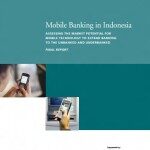



A study for the IFC, supported by AusAid.
Executive Summary
In Indonesia, a large percentage of the population has little or no access to financial services due to geographical, infrastructural and cost barriers. With only 50-60 million Indonesians, out of a total population of 250 million, estimated to have bank accounts and, by our estimates, between 96 million and 114 million actual mobile subscribers, mobile telephone networks look to have a huge potential to provide – and extend the provision of – financial services. Furthermore, the gap between bank account holders and mobile subscribers is only going to increase over the next few years as the mobile subscriber population continues to grow, currently estimated at around 70 million bank account holders and approximately 150 million unique mobile subscribers by 2013.
Where mobile banking has already been made available in Indonesia, it has primarily been as an additional channel for those already holding bank accounts. It has also been disproportionately concentrated upon the larger developed urban areas of Jakarta, Bandung, surabaya, and denpasar, Bali. The questions being addressed here are whether there is demand from those without bank accounts or those with limited access to financial institutions, what that demand may be (i.e., whether it differs from the services being offered by banks and financial services providers), and whether it could be provided via mobile phone networks.
Although m-banking is still in its early stages of development in Indonesia, a number of players have already been becoming act ively involved in various forms of mobile banking and mobile payments services. These early movers primarily come from the leaders of the banking sector and the telecom industry, but they also include third-party platform and software providers. as a result, three distinct models of m-banking service delivery can be drawn: the carrier-led model, the bank-led model and third party models.
We are therefore also here looking at the strategic approaches companies – be they MNOs, banks, or third party providers – can take to reach the unbanked and underbanked populations across the country. The third-party led model offers a particularly interesting option for Indonesia currently in that it is operator-agnostic and benefits from the possibilities offered by the current banking regulations. We strongly encourage further investigation of the possibilities that this nascent model offers for furthering mobile banking adoption in Indonesia.